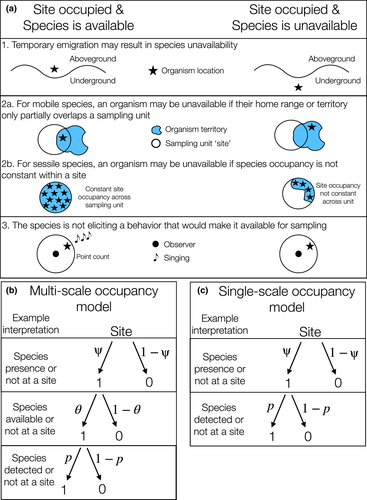Ignoring species availability biases occupancy estimates in single-level occupancy models
Abstract/Summary
1. Most applications of single-level occupancy models do not differentiate between availability and detectability, even though species availability is rarely equal to one. The availability process includes elements of species movement, behavior, and phenology, and availability can be estimated using multi-scale occupancy models. However, for the practical application of multi-scale occupancy models, it can be unclear what a robust sampling design looks like and what the statistical properties of the multi-scale and single-level occupancy models are when availability is less than one.
2. Using simulations, we explore the following common questions asked by ecologists during the design phase of a field study: (Q1) what is a robust sampling design for the multi-scale occupancy model when there are a priori expectations of parameter estimates?, (Q2) what is a robust sampling design when we have no expectations of parameter estimates?, and (Q3) can a single-level occupancy model with a random effects term adequately absorb the extra heterogeneity produced when availability is less than one and provide reliable estimates of occupancy probability?.
3. Our results show that there is a tradeoff between the number of sites and surveys needed to achieve a specified level of acceptable error for occupancy estimates using the multi-scale occupancy model. We also document that when species availability is low (< https://0.40 on the probability scale), then single-level occupancy models severely underestimate occupancy by as much as https://0.40 on the probability scale, produce overly precise estimates, and provide poor parameter coverage. This pattern was observed when a random effects term was and was not included in the single-level occupancy model, suggesting that adding a random-effects term does not adequately absorb the extra heterogeneity produced by the availability process. In contrast, when species availability was high (> 0.60), single-level occupancy models performed similarly to the multi-scale occupancy model.
4. As a companion, we provide an RShiny app that allows users to further explore our results and determine optimal designs across different sampling scenarios https://gdirenzo.shinyapps.io/multi-scale-occ/. Our results suggest that unaccounted for availability can lead to underestimating species distributions using single-level occupancy models, which can have large implications on ecological inference and predictions for practitioners, such as those working at the front lines of invasion ecology, disease emergence, and species conservation.
Publication details
| Published Date: | 2022-05-04 |
| Outlet/Publisher: | Methods in Ecology and Evolution |
| Media Format: |
ARMI Organizational Units:
Northeast - BiologyTopics:
Quantitative DevelopmentsKeywords:
detection probabilityoccupancy
sampling design

